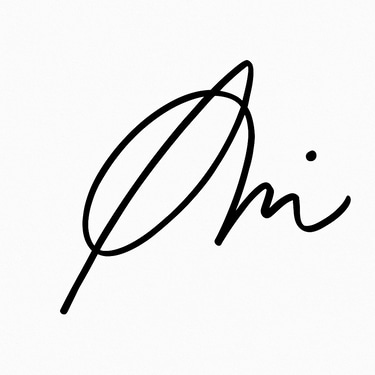List of Publications
Z. Wang, L. Chen, T. Zang, A. N. Bakhtiyari, D. Qi, Y. Wu, W. Yu, H. Zheng, (2025), “Enhancing optical integration: One-step fabrication of multilevel and bifocal Fresnel diffractive microlenses with high focusing efficiency via two-photon polymerization”, Journal of Manufacturing Processes, Volume 149, 111451. DOI: 10.1016/j.jmapro.2025.05.071 (SJR Q1)
Research Spotlights:
This study demonstrates a one-step two-photon polymerization (TPP) method for fabricating multilevel and bifocal Fresnel diffractive microlenses (FDMLs) with record-high performance. The 8-level single-focus FDML achieved an experimental focusing efficiency of 83.6% and a submicron focal spot size (FWHM) of 1.31 μm, closely matching theoretical predictions. Bifocal FDMLs delivered dual-distance focusing with FWHM as low as 1.23 μm and efficiencies exceeding 24% at both focal points. Finite-Difference Time-Domain (FDTD) simulations validated that increasing the number of phase levels improves focusing precision and reduces diffraction artifacts. This scalable, alignment-free TPP approach enables high-efficiency micro-optics for compact and integrated photonic systems.
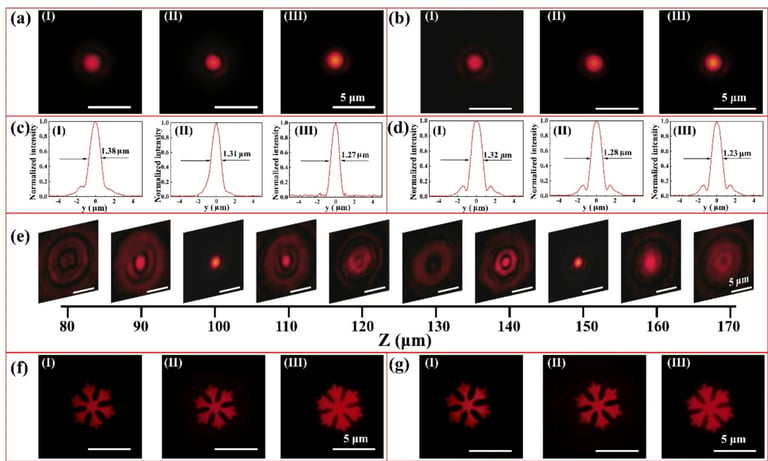

Z. Wang, Y. Wu, L. Chen, A. N. Bakhtiyari, W. Yu, D. Qi, H. Zheng, (2025), “Spatial light assisted femtosecond laser direct writing of a bionic superhydrophobic Fresnel microlens arrays”, Optics & Laser Technology, Volume 180, 111451. DOI: 10.1016/j.optlastec.2024.111451 (SJR Q1)
Research Spotlights:
This article presents a novel method for fabricating bionic superhydrophobic Fresnel microlens arrays (FMLAs) using spatial light-assisted femtosecond laser direct writing combined with surface chemical modification. Inspired by the Nepenthes Alata plant, the researchers designed crescent-shaped microstructures that mimic natural surfaces, aiming for enhanced outdoor performance with self-cleaning and water-repellent properties. The study systematically explores the effects of microstructure geometry, fabrication parameters, and surface treatment on the hydrophobic and optical properties of the FMLAs. The results demonstrate that the fabricated arrays achieve superhydrophobicity with contact angles around 150°, excellent optical imaging performance, and durability in outdoor environments, making them promising for optical system applications in variable weather conditions.
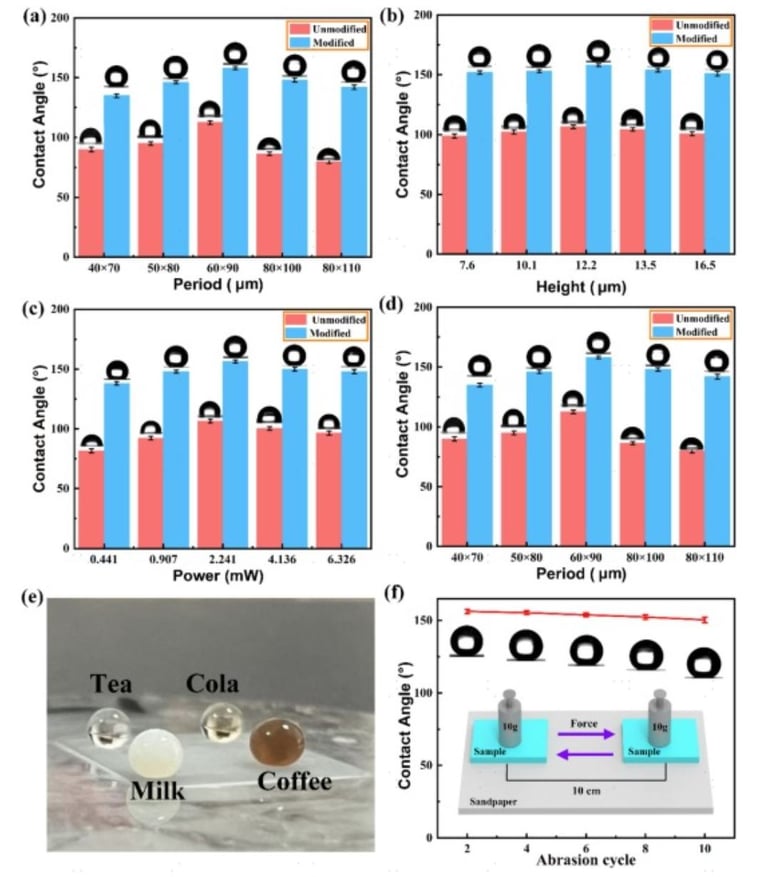

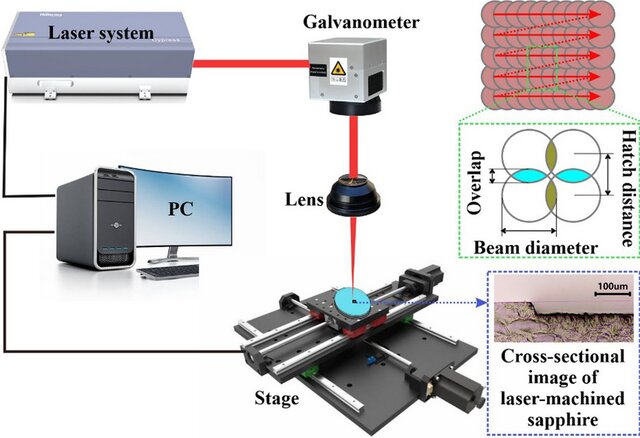

A. N. Bakhtiyari, M. Omidi, A. Yadav, Y. Wu, H. Zheng, (2024), “AI-based modeling and multi-objective optimization of ultraviolet nanosecond laser-machined sapphire”, Applied Physics A, Volume 130,101. DOI: 10.1007/s00339-023-07259-9 (SJR Q2)
Research Spotlights:
This study introduces a novel two-step approach combining support vector machine (SVM) and non-dominated sorting genetic algorithm II (NSGA-II) to model and optimize ultraviolet nanosecond laser machining of sapphire. The SVM models accurately predict key machining outcomes—depth and surface roughness—based on experimental data, demonstrating low prediction errors. These models then serve as objectives within the NSGA-II algorithm to achieve optimal trade-offs—maximizing depth while minimizing roughness—providing tailored solutions for specific engineering needs. This integrated method offers a powerful tool for precise control of laser machining processes, showcasing significant potential for advanced manufacturing applications.
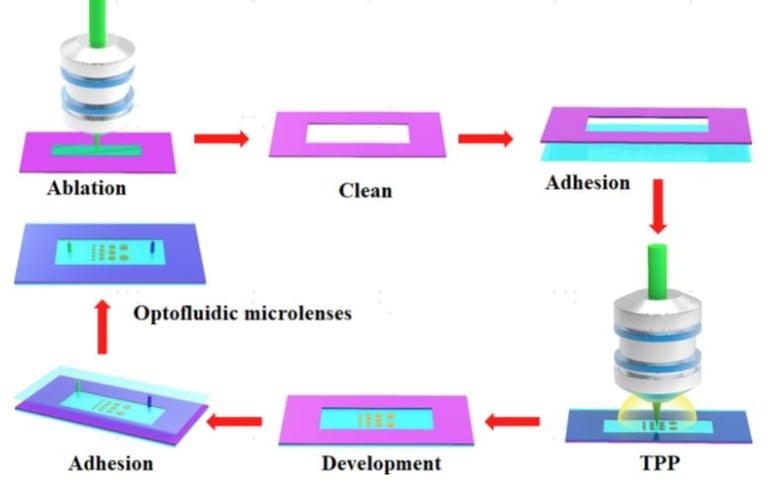

Z. Wang, Y. Wu, W. Yu, D. Qi, A. N. Bakhtiyari, H. Zheng, (2024), “Investigation into fabrication and optical characteristics of tunable optofluidic microlenses using two-photon polymerization”, Optics Express, Volume 32, Pages 7448-7462. DOI: 10.1364/OE.515245 (SJR Q1)
Research Spotlights:
This article introduces a novel approach to fabricating inherently tunable optofluidic microlenses using two-photon polymerization (TPP). Unlike traditional microlenses that depend on external forces for tuning, these microlenses incorporate a three-layered design that allows dynamic control over refractive indices within microchannels, enabling adjustable focus, numerical aperture, and spot size. The TPP-made structures demonstrate precise, self-tunable optical properties without additional external equipment. This advancement enhances optofluidic technology, opening new possibilities for adaptive imaging, variable focal length microscopy, and integrated optical systems.
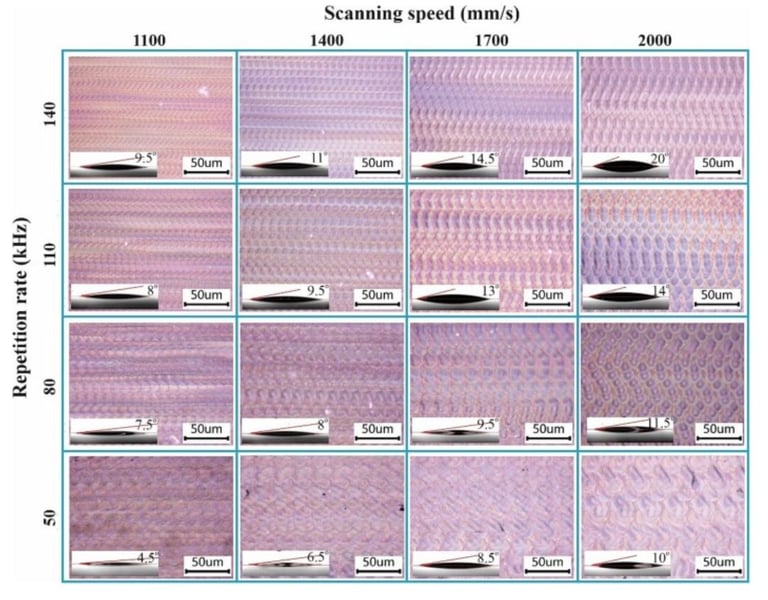

A. N. Bakhtiyari, A. Yadav, Y. Wu, H. Zheng, (2023), “Enhancing wettability of sapphire (Al2O3) substrate through laser surface texturing”, Materials Letters, Volume 355, 135506. DOI: 10.1016/j.matlet.2023.135506 (SJR Q2)
Research Spotlights:
This study explores laser surface texturing as a technique to enhance the wettability of sapphire (Al₂O₃) substrates. By applying precise laser treatments, the researchers create micro- and nanotextures on the sapphire surface, significantly improving its hydrophilicity. The optimized laser processes result in surfaces with lower contact angles, which can be tailored for specific applications. This method offers a scalable and environmentally friendly way to modify sapphire surfaces for uses in optoelectronics, biomedical devices, and coatings, expanding the practicality of sapphire in advanced technological applications.
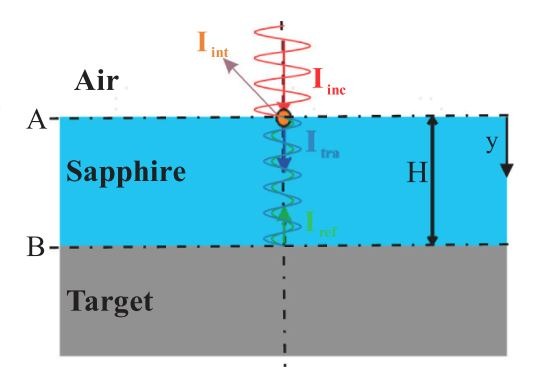

A. N. Bakhtiyari, K. Wang, C. Wang, Y. Wu, H. Zheng, (2023), “Effect of using reflective target materials on enhancing UV nanosecond laser machining of sapphire”, Optik, Volume 290, 171333. DOI: 10.1016/j.ijleo.2023.171333 (SJR Q2)
Research Spotlights:
This study explores a novel approach to enhancing UV nanosecond laser machining of sapphire by placing reflective target materials, such as aluminum and silicon, beneath the substrate. Through a combination of parametric calculations, FDTD simulations, and experimental validation, the authors demonstrate that these reflective materials amplify laser intensity at the sapphire surface due to constructive interference between incident and reflected beams. Among the tested materials, aluminum showed superior performance owing to its higher reflectivity, increasing the machined depth from 21.6 µm (no target) to 26.5 µm. This method offers a simple and cost-effective way to improve material removal efficiency in laser micromachining of hard, transparent materials. The findings provide valuable insights for optimizing laser processing systems in applications such as optics, electronics, and biomedical devices.
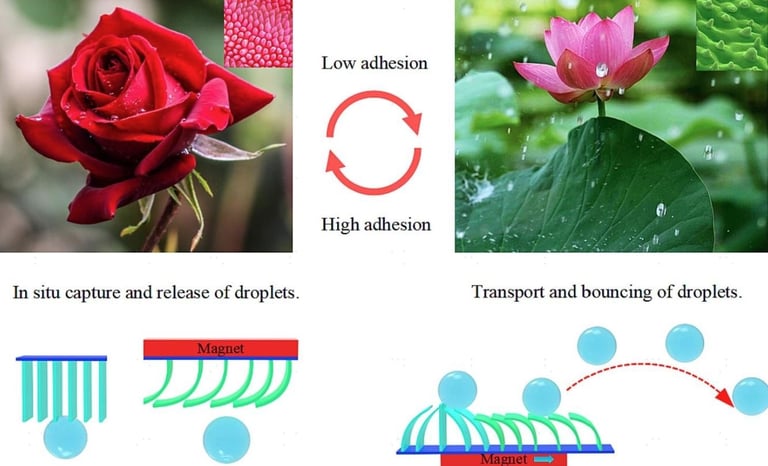

K. Wang, A. N. Bakhtiyari, Y. Wu, M. Liu, H. Zheng, (2023), “Magneto-responsive wettability-switchable surfaces for in-situ large distance droplets capturing-releasing-bouncing”, Chemical Engineering Journal, Volume 478:147420. DOI: 10.1016/j.cej.2023.147420 (SJR Q1)
Research Spotlights:
This study presents the development of superhydrophobic magnetically responsive micro-plate arrays (SMMAs) capable of reversible wettability switching for precise, remote-controlled droplet manipulation. Through laser texturing on one side of bent micro-plates, the surfaces achieve high contact angles (151°) and low rolling angles (<10°), enabling in-situ droplet capture and release with tunable adhesion. The application of magnetic fields deforms the plates to enable directional bouncing of droplets, achieving horizontal jumps up to 24.7 mm and vertical heights of 4.5 mm. This system supports droplet volumes from 5–40 µL and demonstrates significant potential for chemical handling, non-contact reagent transfer, and environmental sensing. The approach offers a robust, reusable, and contamination-free platform inspired by natural wetting surfaces like lotus leaves and rose petals.
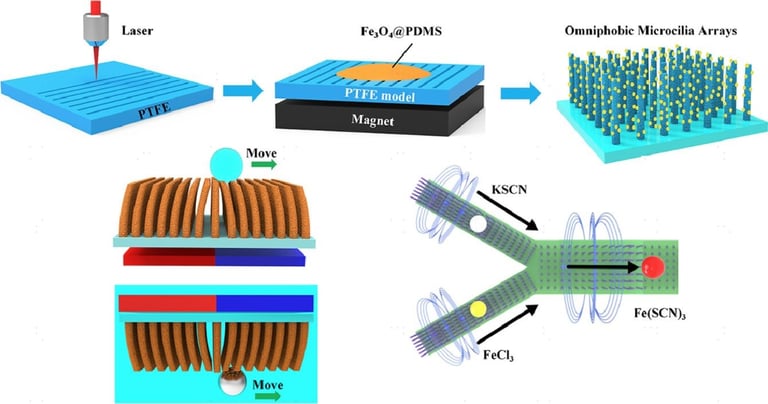

K. Wang, A. N. Bakhtiyari, Y. Wu, M. Liu, H. Zheng, (2023), “Magnetic-responsive Fe3O4@PDMS@SiO2 omniphobic microciliary arrays for dynamic manipulation of droplets and spheres”, Surface and Interfaces, Volume 42, 103487. DOI: 10.1016/j.surfin.2023.103487 (SJR Q1)
Research Spotlights:
In a groundbreaking study published in Surfaces and Interfaces (Vol. 42, Part B, 2023), Kongbo Wang, Ali Naderi Bakhtiyari, and colleagues present a novel approach to dynamic multi-substance manipulation using Fe₃O₄@PDMS@SiO₂ omniphobic microciliary arrays (MMAs). Fabricated through nanosecond laser machining and PDMS replication, these magnetically-responsive structures enable precise and directional transport of water and oil droplets, air bubbles, and solid spheres across both air and liquid environments.The MMAs exhibit excellent omniphobicity, with water contact angles >140°, oil contact angles of 129°, and rolling angles <3°, making them ideal for self-cleaning and anti-fouling applications. Under magnetic actuation, the microcilia deform in wave-like patterns, enabling high-speed transport (up to 2.4 mm/s) of objects as heavy as 2 grams. This work demonstrates a versatile and efficient platform for microfluidics, drug delivery, and lab-on-a-chip systems, with potential impacts across biomedical and chemical engineering fields.
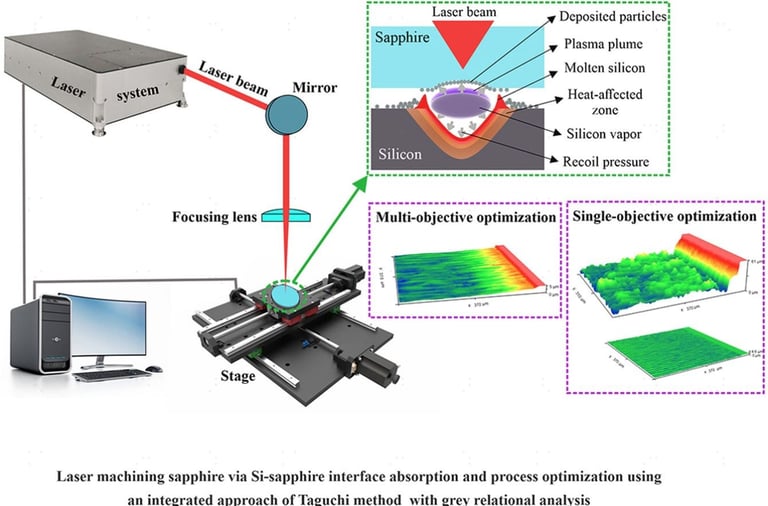

A. N. Bakhtiyari, Y. Wu, L. Wang, Z. Wang, H.Y. Zheng, (2023), “Laser machining sapphire via Si-sapphire interface absorption and process optimization using an integrated approach of the Taguchi method with grey relational analysis”, Journal of Materials Research and Technology, Volume 24, Pages 663-674. DOI: 10.1016/j.jmrt.2023.02.218 (SJR Q1)
Research Spotlights:
This study introduces an innovative strategy to overcome the low laser absorption challenge in sapphire micromachining. By leveraging a silicon-sapphire interface, where a Si layer enhances near-infrared laser energy absorption, the study demonstrates a significant improvement in machining performance through plasma-induced ablation.Utilizing a 1030 nm, 2 ns pulsed laser, the team achieved precise rear-surface machining of sapphire with optimized quality outcomes. They employed a Taguchi L27 orthogonal design integrated with Grey Relational Analysis (GRA) to perform both single- and multi-objective optimization of key process parameters—such as fluence, repetition rate, and scan speed. The results revealed a maximum machining depth of 59.1 μm and a minimum surface roughness of 0.145 μm, showcasing a robust, data-driven method for enhancing process quality. This hybrid statistical approach not only offers a pathway to high-efficiency, crack-free machining of hard transparent materials but also paves the way for applications in microfluidics, optics, and advanced electronics where precision sapphire structuring is essential.
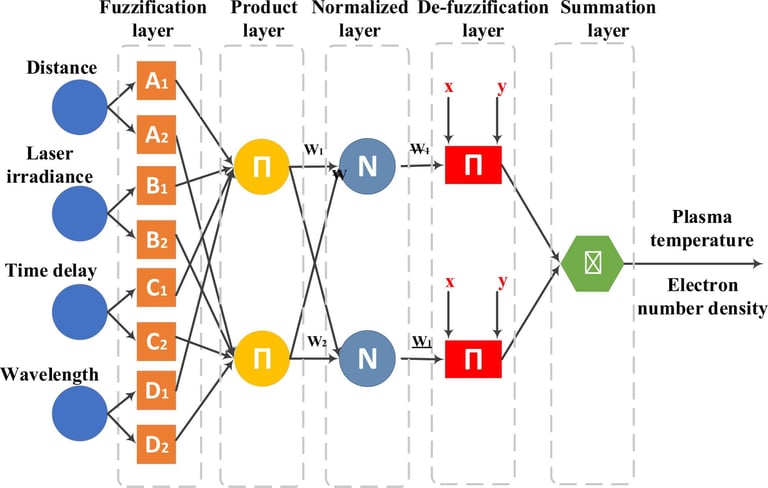

A. N. Bakhtiyari, Y. Wu, D. Qi, H.Y. Zheng, (2023), “Modeling temporal and spatial evolutions of laser-induced plasma characteristics by using machine learning algorithms”, Optik, Volume 272, 170297. DOI: 10.1016/j.ijleo.2022.170297 (SJR Q2)
Research Spotlights:
We developed robust machine learning models—Artificial Neural Networks (ANN) and Adaptive Neuro-Fuzzy Inference Systems (ANFIS)—to predict the spatial and temporal evolution of laser-induced cadmium plasma characteristics. Leveraging experimental data from LIBS (Laser-Induced Breakdown Spectroscopy), the models accurately estimated key plasma parameters such as temperature and electron number density, achieving correlation coefficients above 0.99. The results revealed that plasma characteristics are highest near the target surface and shortly after laser pulse, with clear dependencies on laser wavelength and irradiance. This research demonstrates the power of AI in capturing complex plasma behavior and provides a low-cost, data-driven tool for optimizing plasma-based manufacturing and diagnostics.
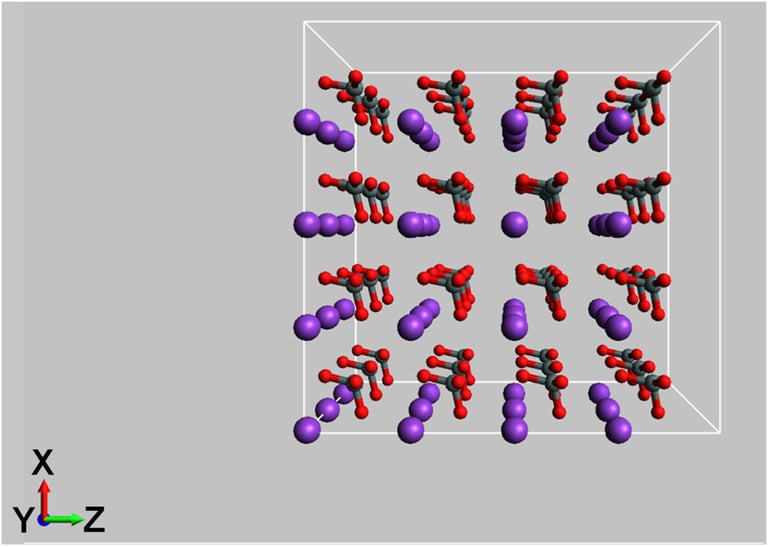

M. Omidi, Z. Karimi, S. Rahmani, A. N. Bakhtiyari, M. K. Abdolmaleki, (2023), “Molecular dynamic study of perovskite with improved thermal and mechanical stability for solar cells application: Calculation of the final strength of the modeled atomic structures and Young's modulus”, Engineering Analysis with Boundary Elements, Volume 156, Pages 1-7. DOI: 10.1016/j.enganabound.2023.07.037 (SJR Q1)
Research Spotlights:
This study presents a comprehensive molecular dynamics investigation of XSnO₃ (X = Cs, Rb, K) perovskite structures to evaluate their mechanical integrity and performance in solar cell applications. Utilizing the LAMMPS simulation platform, the research assesses stress-strain behavior and Young's modulus in three spatial directions under varying thermal and pressure conditions. The findings reveal that CsSnO₃ exhibits the highest mechanical strength and solar efficiency, reaching a power conversion efficiency (PCE) of 16.11% with notable thermal resilience. These insights emphasize the potential of lead-free perovskites as eco-friendly, mechanically stable alternatives for next-generation photovoltaic devices, particularly in environments subject to thermal fluctuation and mechanical stress. The results also demonstrate how computational modeling can guide the design of durable and efficient solar materials before costly experimental trials.

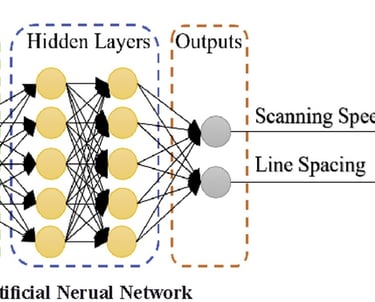
A. N. Bakhtiyari, Z. Wang, H.Y. Zheng, (2021), “Feasibility of artificial neural network on modeling laser-induced colors on stainless steel”, Journal of Manufacturing Processes, Volume 65, 471-477. DOI: 10.1016/j.jmapro.2021.03.044 (SJR Q1)
Research Spotlights:
This study pioneers the application of artificial neural networks (ANN) to model and optimize the laser color marking (LCM) process on stainless steel surfaces. Traditionally reliant on trial-and-error, the LCM process faces challenges with color consistency due to the sensitivity of oxide layer formation to multiple laser parameters. By training ANN models on experimental data, the researchers developed two predictive frameworks: one to estimate the resulting RGB colors from given processing parameters, and another to inversely determine the parameters needed to reproduce a target color. The models demonstrate high accuracy and generalization capability, significantly reducing experimental effort and enhancing repeatability in LCM. The work highlights a transformative step toward intelligent, data-driven laser surface engineering, enabling efficient fabrication of full-color artwork and patterns on metallic surfaces for industrial and decorative applications.
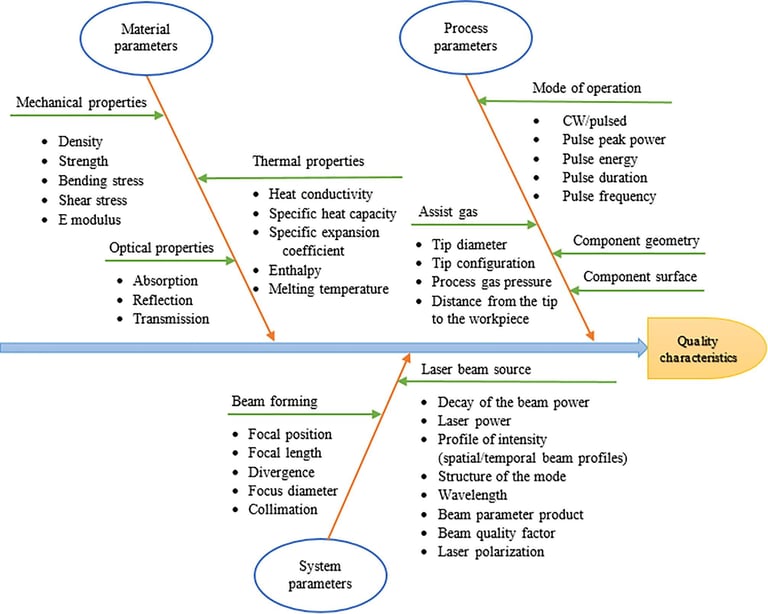

A. N. Bakhtiyari, Z. Wang, L. Wang, H.Y. Zheng, (2021), “A review on applications of artificial intelligence in modeling and optimization of laser beam machining”, Optics & Laser Technology, Volume 135, 106721. DOI: 10.1016/j.optlastec.2020.106721 (SJR Q1)
Research Spotlights:
This review explores how artificial intelligence (AI) is revolutionizing laser beam machining (LBM), a widely adopted non-conventional process for precision material removal. It critically evaluates AI applications—including artificial neural networks, fuzzy logic, metaheuristic algorithms, and hybrid models—for modeling and optimizing key quality characteristics such as surface roughness, dimensional accuracy, and material removal rate. By capturing the complex, nonlinear relationships between laser parameters and machining outcomes, AI enables predictive modeling, process optimization, and intelligent control across various LBM processes like cutting, drilling, milling, and grooving. The review also provides a comparative guide for selecting suitable AI methods tailored to specific challenges and outlines promising future research directions to advance smart manufacturing through AI-powered LBM.
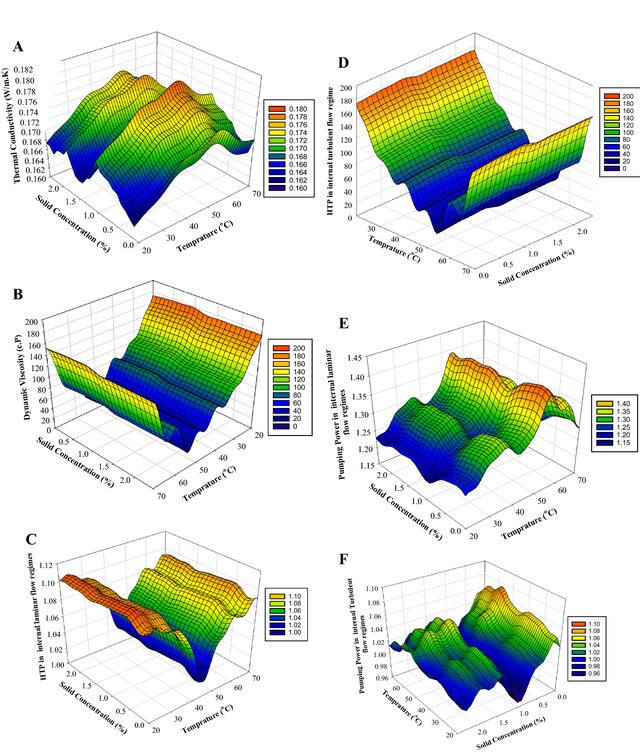

A. Asadi, A. N. Bakhtiyari, I. M. Alarifi, (2021), “Predictability evaluation of support vector regression methods for thermophysical properties, heat transfer performance, and pumping power estimation of MWCNT/ZnO-engine oil hybrid nanofluid”, Engineering with computers, Volume 37. Pages 3813-3823. DOI: 10.1007/s00366-020-01038-3 (SJR Q1)
Research Spotlights:
This study showcases the potential of support vector regression (SVR) as a powerful predictive tool for evaluating the thermophysical behavior of MWCNT/ZnO–engine oil hybrid nanofluids. By leveraging SVR with a Gaussian kernel and Bayesian optimization for hyperparameter tuning, the model successfully predicts key performance metrics—including thermal conductivity, dynamic viscosity, heat transfer performance, and pumping power—across varying temperatures and solid concentrations in both laminar and turbulent flow regimes. Validation using tenfold cross-validation and standard statistical indicators (RMSE, MAE, and R) confirms the model’s robustness and high accuracy. The findings reveal that thermal conductivity and pumping power increase with temperature, while the effects of solid concentration differ across properties. This work highlights SVR's ability to capture complex nonlinear relationships in multiphase fluids and offers a scalable AI-based framework for enhancing thermal system design and nanofluid application in engineering systems.
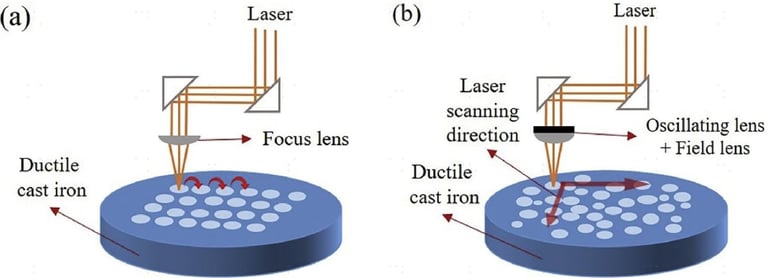

W. Liu, Z. Wang, W. Yuan, W. Tian, X. Sun, C. Wang, A. N. Bakhtiyari, J. Cong, H. Zheng, (2021), “Simultaneous laser in-situ generation of graphene and micro-textures on ductile iron and their effects on tribological properties”, Journal of Materials Research and Technology, Volume 15, Pages 6541-6550. DOI: 10.1016/j.jmrt.2021.11.091 (SJR Q1)
Research Spotlights:
This study presents a highly efficient picosecond laser process that simultaneously fabricates micro-textures and induces multilayer graphene on ductile iron surfaces, achieving a production speed over 1300 times faster than conventional spot-by-spot methods. By tuning laser scanning speed, the researchers controlled the dimple geometries—ranging from 28 to 53 μm in diameter and with area densities between 15% and 30%—to optimize tribological performance. The optimum surface, with a 20% texture density and an average dimple diameter of 36 μm, demonstrated a 70% reduction in wear rate and a 20% decrease in friction coefficient compared to untextured samples. Complementary CFD simulations revealed that the micro-textures induce hydrodynamic lubrication effects, while the in-situ generated graphene enhances thermal diffusion and debris capture, collectively contributing to significant improvements in wear resistance and friction performance.
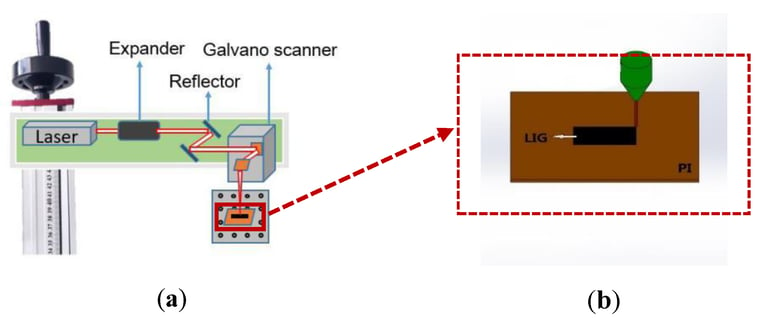

L. Wang, Z. Wang, A. N. Bakhtiyari, H.Y. Zheng, (2020), “A comparative study of laser-induced graphene by CO2 infrared laser and 355 nm Ultraviolet (UV) laser”, Micromachines, Volume 11(12), Page 1094. DOI: 10.3390/mi11121094 (SJR Q2)
Research Spotlights:
This study compares the formation of laser-induced graphene (LIG) on polyimide (PI) using a CO₂ infrared laser (10.6 μm) and a 355 nm ultraviolet (UV) laser, focusing on differences in morphology, atomic composition, sheet resistance, and Raman spectra. Both lasers successfully converted PI into graphene primarily through photothermal effects, with the UV laser also inducing photochemical reactions. The CO₂ laser produced LIG with fewer layers, better crystallinity, and lower sheet resistance (down to 20 Ω/sq), while the UV laser created nanostructured pores and a higher defect density. Overall, the CO₂ laser demonstrated superior performance for high-quality LIG fabrication on PI substrates.
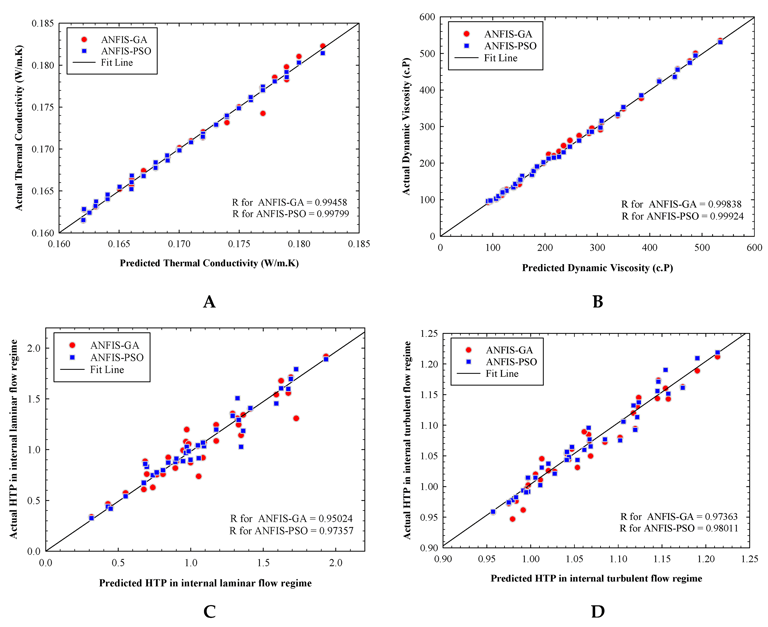

I. M. Alarifi, H. M. Nguyen, A. N. Bakhtiyari, A. Asadi, (2019), “Feasibility of ANFIS-PSO and ANFIS-GA models in predicting thermophysical properties of Al2O3-MWCNT/Oil hybrid nanofluid”, Materials, Volume 12, Issue 21. DOI: 10.3390/ma12213628 (SJR Q2)
Research Spotlights:
This study evaluates the effectiveness of hybrid AI models—ANFIS-PSO and ANFIS-GA—in predicting the thermophysical properties of Al₂O₃-MWCNT/oil hybrid nanofluids. Temperature and nanoparticle concentration were used as inputs, while thermal conductivity, dynamic viscosity, heat transfer performance, and pumping power served as outputs in both laminar and turbulent flow regimes. Experimental data were used to train and test the models, and results showed that both models performed well; however, the ANFIS-PSO model consistently outperformed the ANFIS-GA model in accuracy. This demonstrates that combining adaptive neuro-fuzzy inference systems with metaheuristic optimization significantly enhances prediction reliability in complex nanofluid applications.
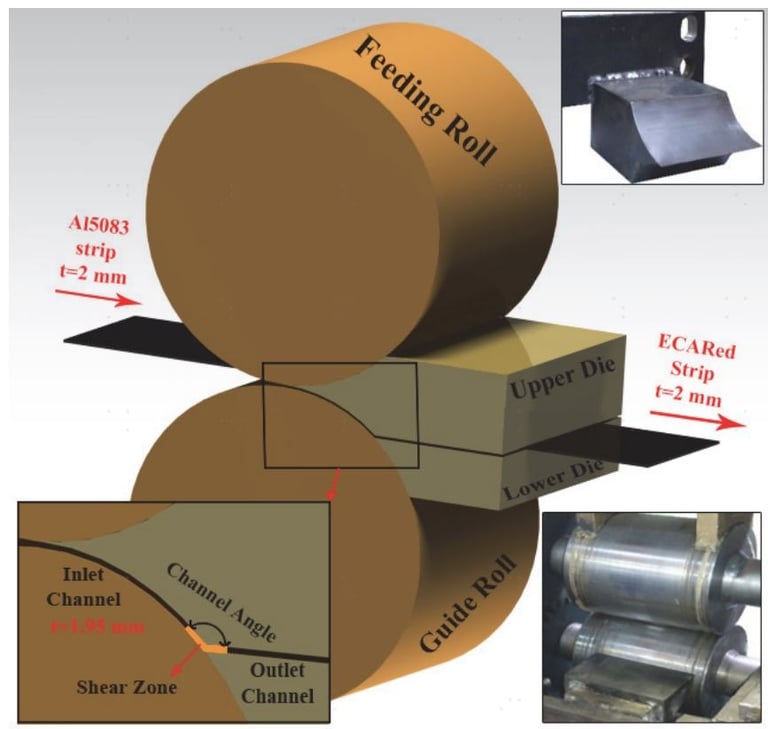

M. Mahmoodi, A. N. Bakhtiyari, (2019), “Microstructure and its relationship to mechanical properties in equal channel angular rolled Al6061 alloy sheets”, Iranian Journal of Materials Forming, Volume 6, Issue 1, Pages 16-23. DOI: 10.22099/ijmf.2019.31820.1118 (ISC Journal)
Research Spotlights:
This study investigates how microstructural evolution during Equal Channel Angular Rolling (ECAR)—a severe plastic deformation technique—affects the mechanical properties of Al6061 alloy sheets. Using the Rietveld method on X-ray diffraction data, the authors quantified changes in crystallite size, microstrain, and dislocation density. Results reveal that increasing strain during ECAR leads to finer crystallite structures and higher dislocation densities. These microstructural changes correlate directly with significant improvements in yield strength and microhardness, as explained by the Taylor equation, underscoring ECAR's effectiveness in enhancing the mechanical performance of aluminum alloys through structural refinement.
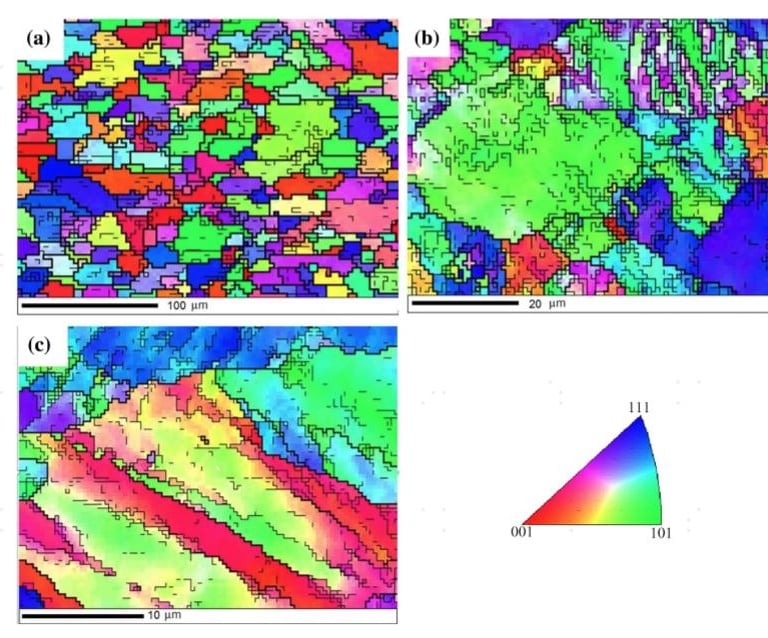

M. Mahmoodi, A. N. Bakhtiyari, G. Dini, (2017), “Correlation between microstructure and mechanical properties of Al5083 alloy sheets processed by equal channel angular rolling”, Journal of Materials Engineering and Performance, Volume 26, Pages 6022-6027. DOI: 10.1007/s11665-017-3021-z (SJR Q2)
Research Spotlights:
This study explores the relationship between structural parameters and mechanical properties of Al5083 alloy sheets processed through Equal Channel Angular Rolling (ECAR). The authors subjected samples to multiple ECAR passes with varying die angles (110°, 120°, 130°) and processing routes. Microstructural changes were assessed using X-ray diffraction and EBSD, with the Rietveld method applied to extract parameters such as microstrain, crystallite size, and dislocation density. The results showed that ECAR significantly increases dislocation density and microstrain while refining crystallite size. These structural changes correlated with enhanced mechanical properties, particularly yield strength, which aligned well with predictions from the Taylor equation, confirming the role of dislocation mechanisms in strengthening ECAR-processed alloys.
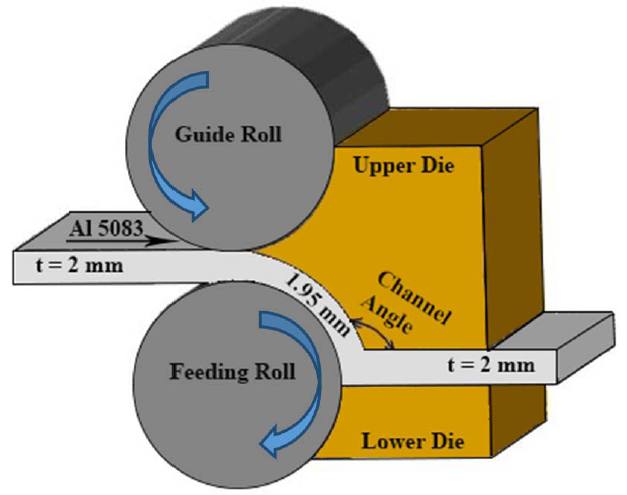

M. Mahmoodi, A. N. Bakhtiyari, (2016), “Applicability of artificial neural network and nonlinear regression to predict mechanical properties of equal channel angular rolled Al5083 sheets”, Latin American Journal of Solids and Structures, Volume 13, Pages 1515-1525. DOI: 10.1590/1679-78252154 (SJR Q2)
Research Spotlights:
This study investigates the applicability of artificial neural networks (ANN) and nonlinear regression for predicting the mechanical properties of Al5083 alloy sheets processed by Equal Channel Angular Rolling (ECAR), a severe plastic deformation technique aimed at producing ultrafine-grained structures. A multilayer perceptron (MLP) feed-forward ANN model was trained using input parameters such as channel angle, number of passes, and feeding route, with tensile strength, elongation, and hardness as outputs. The model’s predictions were compared with those of a nonlinear regression approach and validated against experimental data. The results demonstrate that both methods are effective, but the ANN model provides superior predictive performance. Additionally, the trained ANN model was employed to analyze how ECAR parameters influence mechanical properties, offering a powerful tool for optimizing SPD processes.
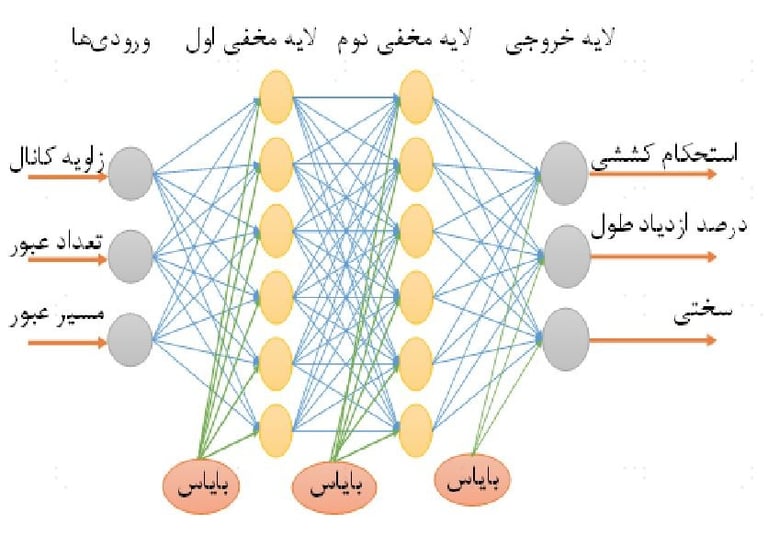

M. Mahmoodi, A. N. Bakhtiyari, (2015), “Prediction of mechanical properties of equal channel angular rolled Al6061 alloy sheet using artificial neural networks and nonlinear regression”, Journal of Modeling in Engineering, Volume 15, Pages 197-207. DOI: 10.22075/jme.2017.2690 (ISC Journal)
Research Spotlights:
This study presents the use of artificial neural networks (ANN) and nonlinear regression to predict the mechanical properties of Al6061 alloy sheets processed by Equal Channel Angular Rolling (ECAR), a technique used to achieve ultrafine-grained structures. A multilayer perceptron (MLP) feed-forward ANN was trained with input parameters including channel angle, number of passes, and feeding route, while the outputs were tensile strength, elongation, and hardness. The ANN and regression model predictions were validated against experimental results, with the ANN model demonstrating superior accuracy. The trained ANN was also used to analyze how ECAR parameters influence mechanical properties, proving to be an effective and economical alternative to extensive physical testing.
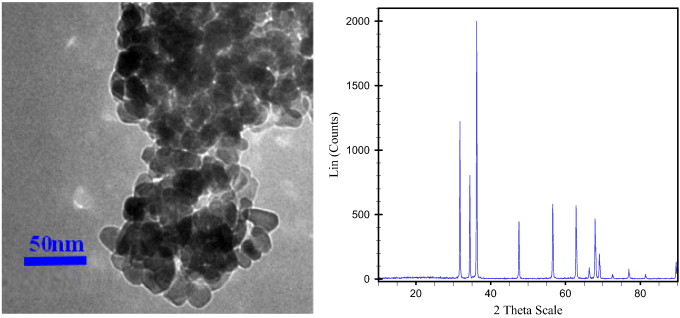

M. H. Esfe, S. Saedodin, A. N. Bakhtiyari, A. Alirezaie, A. Karimipour, S. Wongwises, M. Goodarzi, M. Dahari, (2015), “Modeling of thermal conductivity of ZnO-EG using experimental data and ANN methods”, International Communications in Heat and Mass Transfer, Volume 63, Pages 35-40. DOI: 10.1016/j.icheatmasstransfer.2015.01.001 (SJR Q1)
Research Spotlights:
This study experimentally investigates and models the thermal conductivity of ZnO-ethylene glycol (ZnO-EG) nanofluids using both a nonlinear regression approach and artificial neural networks (ANN). ZnO nanoparticles (18 nm) were dispersed in EG at various volume fractions (0.0625%–5%) and temperatures (24–50 °C) using a two-step method. An empirical correlation and a feedforward multilayer perceptron ANN were developed to predict the thermal conductivity ratio based on input parameters (volume fraction and temperature). The ANN, trained and validated on experimental data, showed superior accuracy compared to the regression model, with a mean squared error of 6.37 × 10⁻⁶. The results confirm that ANN is a powerful tool for accurately predicting nanofluid properties, reducing the need for extensive experimental testing.
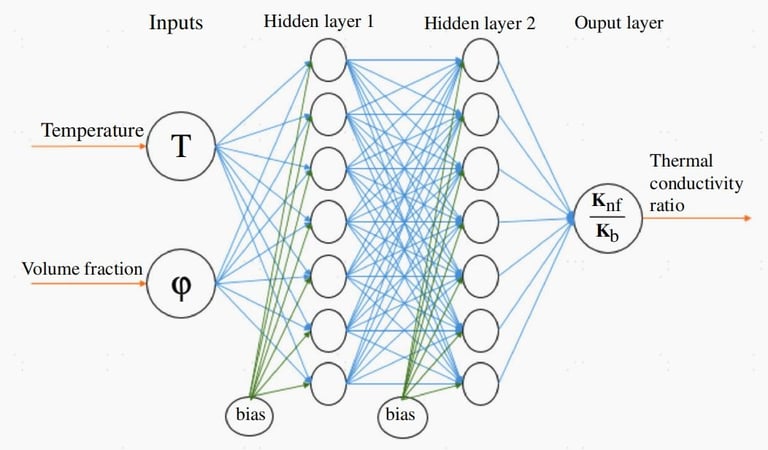

M. H. Esfe, A. N. Bakhtiyari, M. Akbari, M. Afrand, A. Karimipour, (2015), “Evaluation of thermal conductivity of COOH-functionalized MWCNTs/water via temperature and solid volume fraction by using experimental data and ANN methods”, Journal of Thermal Analysis and Calorimetry, Volume 121, Issue 3, Pages 1273-1278. DOI: 10.1007/s10973-015-4565-5 (SJR Q2)
Research Spotlights:
This study investigates the thermal conductivity of COOH-functionalized multi-walled carbon nanotubes (MWCNTs) dispersed in water using both experimental data and artificial neural networks (ANN). Thermal conductivity was measured across various solid volume fractions (up to 1%) and temperatures (25–55 °C). A new empirical correlation was developed based on the experimental results. Furthermore, a multilayer perceptron ANN model was trained using temperature and volume fraction as inputs and thermal conductivity as the output. The ANN demonstrated excellent predictive performance with a mean squared error of 4.04 × 10⁻⁶, confirming its reliability and accuracy for modeling nanofluid thermal conductivity.
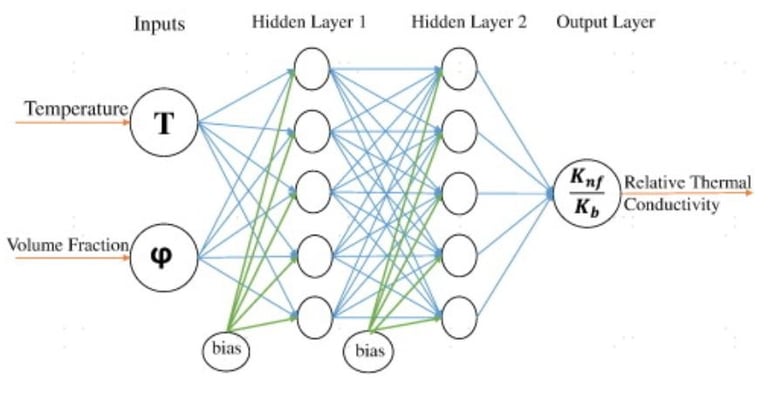

M. H. Esfe, S. Wongwises, A. N. Bakhtiyari, A. Asadi, M. R. Safaei, H. Rostamian, M. Dahari, A. Karimipour, (2015), “Thermal conductivity of Cu/TiO2-water/EG hybrid nanofluid: Experimental data and modeling using artificial neural network and correlation”, International Communications in Heat and Mass Transfer, Volume 66, Pages 100-104. DOI: 10.1016/j.icheatmasstransfer.2015.05.014 (SJR Q1)
Research Spotlights:
In this study published in International Communications in Heat and Mass Transfer, the thermal conductivity of Cu/TiO₂–water/EG hybrid nanofluid was experimentally investigated and modeled using both artificial neural networks (ANN) and nonlinear regression. The nanofluid was prepared via a two-step method and tested at solid concentrations ranging from 0.1% to 2% and temperatures between 30°C and 60°C. The ANN model, using a multilayer perceptron with optimized structure (two hidden layers, five neurons each), achieved outstanding predictive performance (MSE = 2.62×10⁻⁵, R = 0.999), outperforming the correlation-based model. This study confirms that ANN is a reliable tool for accurately predicting the thermal conductivity of hybrid nanofluids.
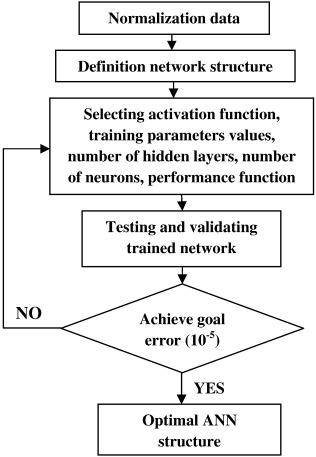

M. H. Esfe, M. Afrand, S. Wongwises, A. N. Bakhtiyari, A. Asadi, S. Rostami, M. Akbari, (2015), “Applications of feedforward multilayer perceptron artificial neural networks and empirical correlation for prediction of thermal conductivity of Mg(OH)2-EG using experimental data”, International Communications in Heat and Mass Transfer, Volume 67, Pages 46-50. DOI: 10.1016/j.icheatmasstransfer.2015.06.015 (SJR Q1)
Research Spotlights:
In this study published in International Communications in Heat and Mass Transfer, the thermal conductivity of Cu/TiO₂–water/EG hybrid nanofluid was experimentally investigated and modeled using both artificial neural networks (ANN) and nonlinear regression. The nanofluid was prepared via a two-step method and tested at solid concentrations ranging from 0.1% to 2% and temperatures between 30°C and 60°C. The ANN model, using a multilayer perceptron with optimized structure (two hidden layers, five neurons each), achieved outstanding predictive performance (MSE = 2.62×10⁻⁵, R = 0.999), outperforming the correlation-based model. This study confirms that ANN is a reliable tool for accurately predicting the thermal conductivity of hybrid nanofluids.
